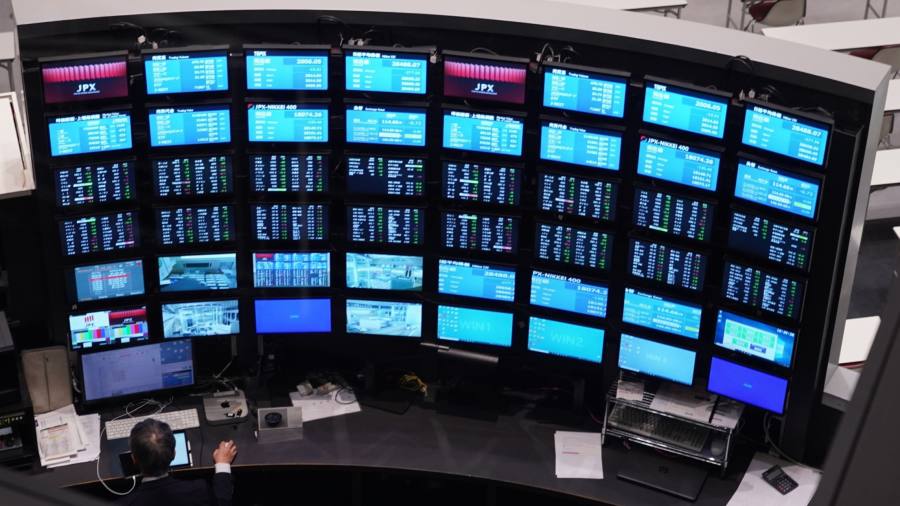Japanese investors have piled into foreign debt this year — but analysts have warned that the revival in demand from one of the cornerstones of the US Treasury market is unlikely to last.
Data from Japan’s ministry of finance reported this week showed that investors bought ¥4.1tn ($30bn) of foreign debt in February, the largest total since September 2021. That follows net buying of ¥1.1tn in January, and marks a pause in the dramatic selling of foreign debt in 2022.
The big rise in yields over the past year in markets outside Japan is theoretically a big draw for the country’s banks, insurers and pension funds, who face rock-bottom returns at home. However, the high cost of hedging foreign bond holdings against swings in the yen exchange rate — which most Japanese investors prefer to do — wipes out those extra returns and was likely to mean the current buying spree is shortlived, analysts said.
“The cost of hedging is already prohibitive and with current expectations about the [US Federal Reserve’s] path, is set to become more prohibitive,” said Brad Setser, a senior fellow at the Council on Foreign Relations. “You’re not going to get the sustained demand from Japan that you got a few years ago.”
Japan has been the biggest foreign owner of US Treasuries for years, as ultra-dovish monetary policy domestically has pushed investors outside the country’s borders in search of returns. Japanese investors also hold substantial quantities of eurozone government debt, particularly French bonds.
However, they dumped large quantities of foreign bonds — of which US debt forms a sizeable proportion — during last year’s historic global fixed-income rout.
Steep interest rate rises from the Fed and other big central banks pushed the yen to a 32-year low in October, and raised the cost for Japanese investors of hedging against currency moves, which depends largely on the rate gap between Japan and elsewhere. While the yen rose at the end of last year, it has weakened 4.3 per cent so far in 2023.
The cost could be set to increase further after Fed chair Jay Powell said this week that the strength of US economic data may lead to the central bank re-accelerating its efforts to lift borrowing costs, having slowed rate rises earlier this year. The European Central Bank is also expected to continue to lift rates this year following a run of strong economic data.
Japanese buying of foreign bonds “ultimately comes down to the hedging costs, which is aligned with the fed funds rate. The cost of funding will dictate foreign flows,” said George Goncalves, head of US macro strategy at MUFG. “The monthly or weekly flows are not always going to be smooth and logical and reflect the hedging costs. But you will see those trends over the longer term.”
Some of the buying in recent weeks may be from Japanese institutions that have more capacity for making unhedged bets, such as pension funds. After the big sell-off last year, some institutional investors may be very underweight foreign debt, so “there is capacity to buy unhedged at the moment”, said Edward Al-Hussainy, senior currency and rates analyst at Columbia Threadneedle.
However the riskiness of unhedged holdings of dollar-denominated debt, which can tumble in value if the yen rebounds against the US currency, is likely to limit the scope for further demand.
A prospective sea change in Japanese monetary policy could eventually help to bring hedging costs down. Though interest rates remain below zero, the reign of Bank of Japan governor Haruhiko Kuroda — the architect of the country’s years of ultra-loose policy — will end after the central bank’s meeting on Friday.
His successor, Kazuo Ueda, has hinted that he may relax or even ditch the BoJ’s policy of pinning 10-year bond yields close to zero, a move that some investors would see as a prelude to eventual rises in interest rates.
But tighter monetary policy in Japan could undermine investors’ rationale for looking at overseas bonds in the first place.
“If the level of yields in Japan starts to go up, suddenly that will make Japanese yield levels more attractive, which might run the risk of Japanese investors asking why they are investing abroad,” said Torsten Slok, chief economist at Apollo Global Management. “That is a major risk to international fixed-income markets.”
Read the full article here



